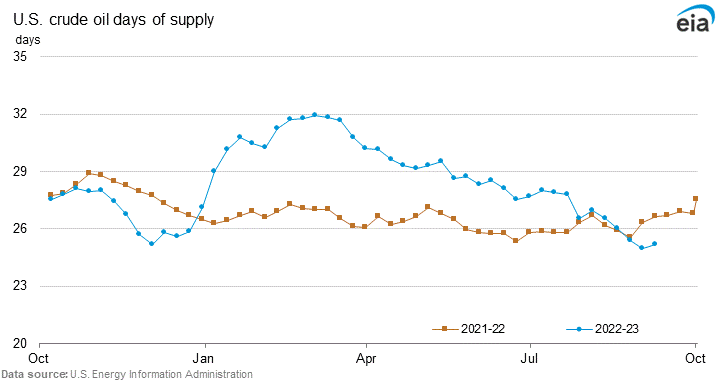 Following a brief decline, oil prices increased on Thursday, propelled by fresh worries over a potential shortage of petroleum in 2023. WTI rose by 19 cents to $88.71, while Brent futures climbed 17 cents to $92.05 a barrel. According to the IEA, the prolonged output cutbacks by Saudi Arabia and Russia indicated a market deficit for Q4. According to OPEC, there will be considerable demand for oil in 2023 and 2024. Despite recent U.S crude and fuel inventory shocks, confidence persists, supported by expectations for strong oil demand and a probable Fed rate delay.
Following a brief decline, oil prices increased on Thursday, propelled by fresh worries over a potential shortage of petroleum in 2023. WTI rose by 19 cents to $88.71, while Brent futures climbed 17 cents to $92.05 a barrel. According to the IEA, the prolonged output cutbacks by Saudi Arabia and Russia indicated a market deficit for Q4. According to OPEC, there will be considerable demand for oil in 2023 and 2024. Despite recent U.S crude and fuel inventory shocks, confidence persists, supported by expectations for strong oil demand and a probable Fed rate delay.
Oils prices and Bent Futures
Following a brief decline the previous day, oil prices increased on Thursday as investors’ attention returned to the prospect of a limited supply of petroleum for the remainder of 2023. Benchmark Brent crude saw a 17 cent gain to $92.05 per barrel at 12:02 GMT, while West Texas Intermediate crude (WTI) saw a 19 cent increase to $88.71.
Situation of Benchmarks
The International Energy Agency (IEA), which generally adheres to its estimates for demand growth this year and next, cautioned on Wednesday that the extension of Saudi Arabia and Russia’s oil output cuts until the end of 2023 will result in a major market shortfall through the fourth quarter. The Organization of the Petroleum Exporting Countries (OPEC) said on Tuesday that it expects global oil demand to rise significantly in 2023 and 2024.
Prior to news showing an unexpected increase in U.S crude and gasoline stockpiles that alarmed markets about demand, both benchmarks on Wednesday reached 10-month highs.

U.S Crude Inventory
Despite experts’ predictions of a 1.9 million-barrel reduction in a Reuters poll, U.S oil stocks increased by 4 million barrels last week. As refiners increased their activities, fuel stocks also increased more than was anticipated. [EIA/S]
Expectation on Fed’s Interest Rate Hikes
Investors viewed the most recent estimate of U.S inflation as evidence that the Federal Reserve will not raise interest rates next week and may even prolong its current pause, which boosted expectations for robust oil demand.
Borrowing becomes more expensive for individuals and businesses with higher interest rates, which might limit economic growth and reduce oil consumption.
Bottom Line
As a result of worries about a limited supply of petroleum in 2023, oil prices have recently increased. With Saudi Arabia and Russia extending output cutbacks, Brent futures reached $92.05 and WTI touched $88.71, resulting in a predicted Q4 market imbalance. OPEC continues to be upbeat about robust demand in 2023 and 2024. Despite unexpected gains in U.S inventories, optimism remains because of a possible Federal Reserve rate delay, which supports forecasts of strong oil demand. However, higher interest rates may have a negative impact on oil demand and economic development.
